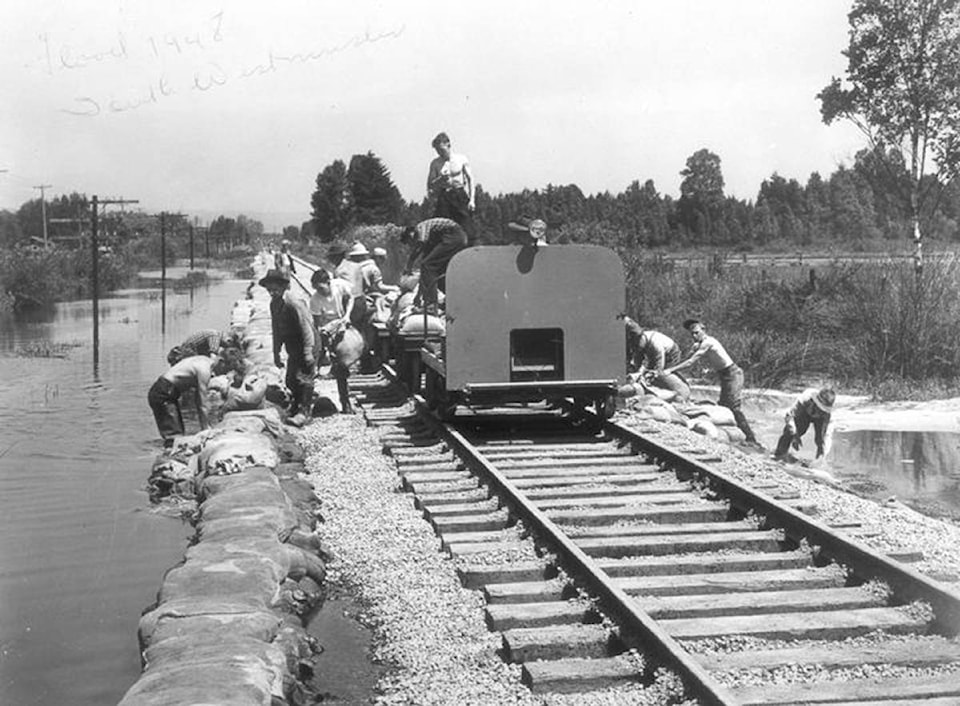Every recorded catastrophic flood on the Fraser River has happened in the month of May. A large snowpack coupled with a warm spring causes a fast melt and the river to overflow its banks. The flood plains of the Fraser Valley are particularly vulnerable.
In May of 1894, the Fraser River had its largest recorded flood; Abbotsford and Chilliwack were particularly hard hit. North Delta lay above the flood waters, but farmers in South Westminster to the north and Ladner to the south faced weeks of their land and homes inundated with murky silt-laden water. The communities of North Delta opened their homes and fields to accommodate their less fortunate neighbours and their livestock.
There was another devastating Fraser flood in May of 1948. High schools were closed so that students could go down to the riverside to help fill and pack sandbags to shore up against the rising waters in the stricken communities. With a larger population compared to during the 1894 flood, 22,000 people in the Fraser Valley had to be evacuated. Again, North Deltans opened their homes and fields to neighbouring communities.
Les Starheim, a longtime resident of Annieville, remembers the 1948 flood and how the spit of land that separated Gunderson Slough from the main river channel was submerged and the sheds that accommodated boat builders, net sheds, boat mechanics and other marine businesses had water up to the floorboards. Generally, though, the boats were safe as they rose with the swollen river and fell with the tide.
RELATED: HISTORY: Memories of 1948 Fraser River floods still run strong
Recognizing that there was a need for flood control measures after the 1948 flood, 250 miles of dykes were built in the 1950s and 1960s and 48 kilometres of the river’s channels were deepened in the lower reach of the Fraser. When waters again rose in 1972, flood conditions were more reasonable controlled, with dykes, prediction and timely sandbagging. However, there was still $10 million of damage, mainly in Prince George and Surrey.
With the increasing population along the Fraser River and the projected increased risk of sea level rise as a result of climate change, a consortium of all levels of government under the auspices of the Fraser Basin Council was formed and a major study was undertaken. The result — phase 1 of the Lower Mainland Flood Management Strategy, published in May 2016 — showed that risks were projected to worsen over the next 85 years. It is estimated that should flooding at the predicted level occur, it would result in $20 to $30 billion dollars of damage, which would be “the most costly natural disaster in Canadian history to date, creating severe strain on the regional, provincial and national economies.”
The group behind the Lower Mainland Flood Management Strategy have met for the past three years to consider the problems of Fraser River and coastal flooding. They have sponsored in-depth research and commissioned experts to compile solutions. On May 21, an interim report will be available to the public outlining the extent of predicted flooding and detailed plans for preventing extensive damage. There will also be an updated atlas of affected areas and online information accompanying the report. After public input, action will be implemented by all levels of government beginning in May, 2020.
Nancy Demwell is a board member with the Delta Heritage Society (formerly the Delta Museum and Archives Society).
RELATED: North Delta history: The fierce frozen Fraser
SEE ALSO: North Delta history: Strife, strikes and militia on the Fraser River
SEE ALSO: North Delta history: The eulachon, a part of our past
editor@northdeltareporter.com
Like us on Facebook and follow us on Twitter
